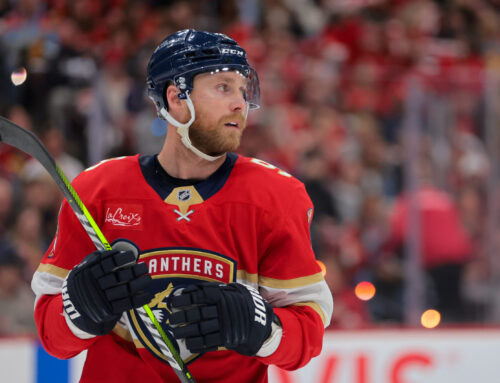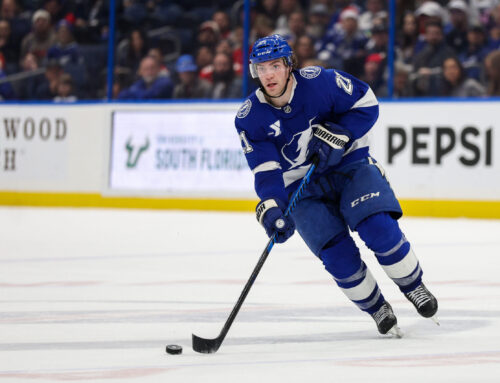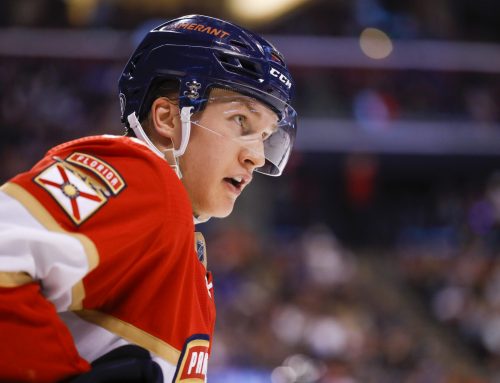Welcome back to Goldipucks and the Three Skaters, a play on words of the Goldilocks and the Three Bears story. Instead of there being three bowls of porridge though, I cover three skaters and declare one too hot (i.e., doing unsustainably better than he should), another too cold (i.e., doing unsustainably worse), and a third “just right” (i.e., producing where he should be). In addition, I also assign each a rating of 1-10, indicating how hot (rated 7-10, where 10 is the most unsustainably hot), cold (rated 1-4, where 1 is the most unsustainably cold), or “just right” (rated 4-7, where 5.5 is the most “just right”) he is.
This is always the toughest edition of Goldipucks to write, as although the regular season is underway there haven't been enough games played thus far so as to make hot, cold, or just right decisions based on what's currently unfolding. You should think of this as one last offseason Goldipucks, with the players this time being Mike Hoffman, Mikko Rantanen, and Rantanen's Avs teammate Samuel Girard. Stop here to guess who was too hot, too cold and just right for 2020-21, then continue on to see if your spidey senses were correct.
Entering this season there were rightful concerns about Hoffman, not just because of him having missed all of training camp and the beginning of the season due to injury, but also in view of how much of a disappointment he was in 2020-21. Was his subpar one season tenure in St. Louis simply a case of a good player in a bad situation, or the writing on the wall in terms of the now 31-year-old Hoffman's days of being a solid fantasy contributor? Based on the data, Hoffman's 2020-21 was a lot better than it seemed, and he's poised to not only resurrect his career in Montreal, but potentially ascend to new heights.
What exactly is lurking behind Hoffman's 2020-21 to suggest his 57-point scoring pace (following back-to-back seasons of 70 point pace) was not, in fact, a let down? For one, he only was given 15:04 of ice time per game in 2020-21, such that he sported a P/60 of 2.8, or just below the 2.9 and 3.0 of his 70-point pace seasons. Really, Hoffman was essentially no worse overall than in his best seasons, just hampered by poor ice time.
Speaking of ice time, Hoffman's 2020-21 man advantage minutes per game was over 90 seconds less than in 2018-19 or 2019-20. Yet still he garnered 17 PPPts in 52 games, i.e., 32.6% of his games, or just below the collective 37.1% from his prior two seasons. He did this by excelling in the minutes he received, as although he only skated for the 136th most PP minutes of any forward, his 17 PPPts tied him for 25th! To further underscore just how great that was, consider no one who had more PPPts than Hoffman had less than 138 total PP minutes, versus 101 for Hoffman, for a 36% edge, and the next highest PPPt total for anyone with a lower total PP TOI was only 13, meaning Hoffman had 30% more PPPts than that player. He's a PP whiz, and Montreal should give him all the PP Time he can handle.
There's also the reality of Hoffman's 2020-21 season-long stats disguising how well he was playing as the campaign wore on, what with 15 points in his last 16 contests, including 11 in his last seven games alone. He did all this without an uptick in his ice time overall or on the PP, and without skating with better linemates. In fact, his most ES frequent linemates in Q4, when he was red hot, were Robert Thomas, Jordan Kyrou, Tyler Bozak, Zach Sanford, and Klim Kostin. No Ryan'O'Reilly, David Perron, or Brayden Schenn in sight. What this showed was Hoffman succeeding because of skill and effort, a testament to that being that his IPP was right at the 65-70% mark within which it had been the previous two seasons.
Plus, if we look at league leaders in slap shot goals for 2020-21, Hoffman was tied for first, with the next five highest totals being Alex Ovechkin, Kyle Connor, Steven Stamkos, Auston Matthews, and David Pastrnak. What do all five have in common? At least one point per game campaign, with all but Connor having had a scoring pace of at least 99 in a season. Lest anyone think this was a one-year fluke, Hoffman ranks third in this area over the past three seasons, with Ovi, Pasta, Stamkos and Matthews also in the top ten. Who were the others rounding out the top ten? Just some guys named Mark Scheifele, Leon Draisaitl, Nikita Kucherov, Nathan MacKinnon and Patrik Laine. While Hoffman's career best in goals per game was 36 in 82 contests in 2018-19, eight of the nine – not Scheifele, but including Connor – have each had at least one season averaging a goal per every other game and even Scheifele had 38 in 82 games in 2018-19. So by being part of this elite club, it suggests Hoffman should see his goal total spike.
While it is possible that Hoffman upped his effort level at the end of 2020-21 in order to secure his next UFA deal, the more logical explanation is he was catching fire. That flame should stay ignited in 2021-22, when he'll get better deployment in Montreal plus still be a weapon on the PP and once again find himself in some of the most elite company with many slap shot goals. All things considered, Hoffman's 2020-21 was TOO COLD, and gets a rating of 2.25, suggesting he should've well surpassed past his prior career high scoring pace and is poised to do so this season.
Who is the real Mikko Rantanen? The player who scored at an 85-point pace four seasons ago but then dipped to 80 two seasons later, yet also scored at a 96-point-rate in the season sandwiched in between? Or perhaps those were just his warm-up acts, and his 104-point pace from 2020-21 is either more in line with what we should expect or perhaps him just scratching the surface? From the data, it looks like the real Rantanen is closer to what we saw in 2018-19 when he tallied 96, rather than the 104-point version from 2020-21.
Beyond worse outputs in the immediately preceding and subsequent seasons, what made Rantanen's 96 point pace in 2018-19 seem like an outlier was his SOG rate in view of how many goals – including PPGs – that he scored. After all, dating back to 2000-01, of the 66 instances of a winger scoring 31+ goals, of which 16+ came on the PP, as did Rantanen in only 74 games in 2018-19, none fired fewer SOG per game than Rantanen's 2.61. Given this, poolies were skeptical as to whether what they saw from Rantanen that season was for real.
Fast forward to now, and after SOG rates of 2.54, 2.61, and 2.19 in his prior three seasons, Rantanen rocketed upward to 3.4 per game in 2020-21. But as important as the fact it rose is his SH% stayed sky high, as Rantanen, tallied a goal on 16.9% of his shots in 2020-21, marking the fourth straight season he had a SH of 16.1%, with it being 15.0% when he was a rookie. Dating back to 1990-91, there were five other forwards who likewise had five or more seasons with a SH% of 15.0+ by age 24 – Steven Stamkos, Jaromir Jagr, Eric Lindros, Connor McDavid, and Keith Primeau. Four superstars out of five, with Primeau being distinguishable by having a goals per game rate through that age which is easily the lowest of the five, and lower than Rantanen's. Moreover, Jagr and Lindros had better seasons as they aged, and McDavid might also, which means Rantanen could still improve beyond this scoring pace or at least see it hold steady.
Or could he? For one, Rantanen's IPP has never been superb, with it being 67.2% – 69.5% in three of the last four seasons, and 73.1% in his 96 point pace season. How do other elite players compare? Looking at the six players who had a point per game scoring rate as high or higher than his for 2020-21, and we find their average was 77.7%. What this means is Rantanen does not have as strong/innate of a nose for scoring as these players, making his 2020-21 output more suspect.
Adding to concern about the sustainability of Rantanen's scoring rate was his secondary assists percentage, which was 50% in 2020-21, after it having dropped in the previous two seasons, from 47.3%, to 39.3% to 27.3%. So it essentially doubled from one season to the next. Looking again at those six players, their average secondary assist rate was 37.4%, or a good bit below what Rantanen did in 2020-21.
Also, while over half – i.e., 31 seconds – of Rantanen's added 58 seconds of total ice time for 2020-21 came on the man advantage, his OZ% spiked to 68.6%, which was well higher than his 60.3% average over his past three seasons and also well higher than the 59.0% average of those same six skaters. Although Colorado is a strong team, which in and of itself will help keep Rantanen's OZ% high, it is unrealistic to envision him being able to continue to receive nearly 20:00 per game of ice time while sporting an OZ% that high. Either it will need to go down or his ice time will, in either case negatively impacting his scoring rate.
There is some good news though. Rantanen had a career best 0.46 PPPts per game, which was a higher than his prior three seasons of, in reverse order, 0.33, 0.44, and 0.43. Those are high rates; but Rantanen's IPP with the man advantage has remained relatively stable, as it was 72.7% last season, 66.7% in 2019-20, 75.0% in 2018-19, and 68.6% in 2017-18. Although this means Rantanen probably won't start sporting a PP IPP above 75%, what has changed since 2018-19 is the addition of Cale Makar, who makes the Avs PP more potent. As such, Rantanen scoring at a PPPt per game rate this high, or perhaps a tad higher, is not out of the question.
There was definitely a lot to like about 2020-21 for Rantanen owners, as he ascended to new per game heights in several areas. His PP scoring was seemingly for real, and his spike in SOG rate didn't lead to a drop in shooting percentage, putting him in elite company; but he nevertheless did objectively overachieve in view of his OZ%, IPP, and secondary assists percentage, each of which was quite subpar compared to those who scored at rates which were comparable to his. While Rantanen is likely to enjoy many more years of top notch scoring, his 2020-21 was TOO HOT, and he gets a rating of 8.0, as he checks out at more of a 95-point-pace player than someone likely to post 100+.
After being selected 47th overall in the 2016 entry draft, Girard immediately made a strong impression to the tune of 75 points in just 59 games in juniors, leading to him playing pro hockey by age 19, first briefly for the Predators and then for the Avs after Colorado landed him in a deal, finishing that season with a 26 point scoring pace, which, as it turned out, was almost identical to his 2018-19 rate as a sophomore. Starting in 2019-20 though, and even as Cale Makar was receiving all the headlines, Girard made strides, scoring at a 40-point pace. He then turned many more heads in 2020-21 when his scoring rate jumped to 55. Is it realistic to expect Girard to score that high with Makar looming large? The answer is yes.
Naturally the thinking is when one defenseman is such a superb scorer – like Makar – there isn't room for another – like Girard – to sustainably produce at the scoring rate Girard did in 2020-21. However, if we look back, there have been several instances where a team had a top dog in terms of blueline offense, but also another strong contributor as well. In fact, it happened as recently as two seasons ago in Nashville, when Roman Josi produced at a 77-point pace and Ryan Ellis at a 64-point clip. It occurred as well in Pittsburgh in 2012-13, when Paul Martin scored at a 55-point pace despite Kris Letang's scoring rate being 89 points. Those of us old enough to remember will recall the many seasons where Nicklas Lidstrom was producing superb numbers for the Red Wings while, at the same time, the likes of Brian Rafalski and/or Mattieu Schneider were scoring at a rate in the 50s or even higher. Lest anyone think Makar's presence disqualifies Girard from being able to continue to score at a 55+ point pace, it can definitely happen, especially on an offensive powerhouse like the Avs.
Okay, so it's not without precedent for Girard to have produced numbers like he did in 2020-21, but what about the elephant in the room, namely Girard's low SOG rate? Based on past comparables, Girard defied the odds by having scored as high as he did despite his low SOG rate, as out of 225 instances of defensemen who scored at a .65 point per game pace or higher dating back to 2000-01, only five had a SOG rate lower than Girard's 2020-21 rate of 1.64 when doing so. One of those was the aforementioned Martin in 2012-13.
If we look past Girard's last ten games of 2020-21, when he had a total of 12 SOG, his rate would've been 1.76 per game, and that just happens to be above Rafalski's 1.68 per game in 2010-11 when Rafalski scored at a 63-point pace. What this underscores is when a defenseman is playing "second fiddle" for an elite team it is plausible for him to score at a 55+ point rate despite shooting the puck a lot less than what would normally be expected.
Does this mean Girard could rise to 60+ points? That might be a long shot, as it not only shrinks the past instances by nearly 100 – to 133 in total – but just one player managed to do so with a SOG rate lower than Girard's for 2020-21, namely Ryan Whitney in 2006-07 and again in 2010-11. Beyond that, Girard's IPP might be maxed out, as it has risen from 32.1% in 2018-19, to 45.3% in 2019-20, to 50.0% last season. That ranked him tied for 18th among all defensemen who played 20+ games in 2020-21, with Makar at 11th with 53.7%. So if someone with the talent and nose for scoring of Makar has an IPP that's barely above that of Girard, yet still ranked Makar that high, it cuts against Girard's rising further.
On the plus side, Girard's best season coincided a career low 40.7% secondary assists percentage, with there clearly room for more secondary assists in general and especially with him being a defenseman. But just as that is good news, there's the reality that Girard was more coddled than ever, starting 62.5% of his shifts in the offensive zone, up from a range of 53.5 to 57.1% in his prior three seasons. On a team that needs to put Makar in a position to maximize his scoring, it is difficult to envision a scenario where Girard is able to keep an OZ% that high, no matter how good the Avs are as a team.
Those of you who held onto Girard even after Cale Makar made a huge rookie splash were nicely rewarded in 2020-21. And although Girard's SOG rate was far lower than those who normally score at a rate as high as his 55 points, when you're a "second fiddle" guy on an elite team you can produce despite shooting less. The chances of him upping his scoring given that, plus as many metrics points down as up, seems remote. Instead, I'd label his 2020-21 as JUST RIGHT, and give him a rating of 5.5, suggesting that roughly 55 points should be expected for him on the up tempo Avs.
************
Questions for Mailbag
My monthly mailbag is in a couple of weeks and has plenty of room for questions. To get yours to me, you can (1) private message “rizzeedizzee” via the DobberHockey Forums or, instead, or (2) email admin@dobbersports.com with “Roos Mailbag” as the subject line.





 TOR
TOR S.J
S.J ANA
ANA EDM
EDM CAR
CAR DET
DET CGY
CGY VAN
VAN MIN
MIN ARI
ARI
